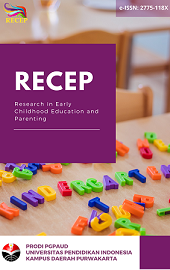HUBUNGAN POLA ASUH ORANG TUA TERHADAP KECENDERUNGAN ANAK MELAKUKAN BULLYING
Abstract
ABSTRACT
This literature study aims to identify the relationship between parental parenting patterns and children's tendencies to bully. Given the significant impact on children's social and psychological development, bullying among teenagers is increasingly becoming a concern. A qualitative approach using literature review methods was used to analyze parenting patterns (authoritarian, permissive and democratic) and bullying tendencies. The study results show that authoritarian parenting styles are positively correlated with bullying behavior, while democratic and permissive parenting styles have lower correlations. These findings emphasize the important role of parental parenting in preventing bullying, with democratic parenting can reduce the possibility of children committing harassment. Collaboration between parents, schools and communities is needed to create an environment that supports children's development.
ABSTRAK
Studi literatur ini bertujuan untuk mengidentifikasi hubungan antara pola asuh orang tua dan kecenderungan anak melakukan bullying. Mengingat dampak signifikan terhadap perkembangan sosial, dan psikologis anak, bullying di kalangan remaja semakin menjadi perhatian. Pendekatan kualitatif dengan metode kajian literatur digunakan untuk menganalisis pola asuh (otoriter, permisif, dan demokratis) dan kecenderungan bullying. Hasil studi menunjukkan bahwa pola asuh otoriter berkolerasi lebih rendah, Temuan ini menegaskan pentingnya peran pola asuh orang tua dalam mencegah bullying, dengan pola asuh demokratis dapat mengurangi kemungkinan anak melakukan aksi bullying. Kolaborasi antar orang tua, sekolah, dan masyarakat diperlukan untuk menciptakan lingkungan yang mendukung perkembangan anak.
Keywords
Full Text:
PDF (Bahasa Indonesia)DOI: https://doi.org/10.17509/recep.v6i1.77536
Refbacks
- There are currently no refbacks.
Copyright (c) 2025 Research in Early Childhood Education and Parenting

This work is licensed under a Creative Commons Attribution-ShareAlike 4.0 International License.

This work is licensed under a Creative Commons Attribution 4.0 International License.



